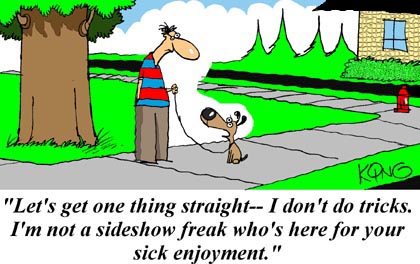 Why
teach sit?
Why
teach sit?
Teaching
your dog
to "sit" on
instruction is one of
the most versatile and important
behaviors your dog can learn.
The "sit"
instruction can be
used to shape a multitude of
desirable behaviors.
Sitting is
a deference posture that
reinforces the dog's status in
the family based on the innate
social structure of the dog.
There are several methods of
teaching the dog to sit, none of
which rely on physical
punishment or reprimands.
|
Asking the dog to sit is
like asking the dog to say,
"Please." |
Luring
the dog to sit
.jpg) For this
method, you hold at treat at the
dog's nose and move SLOWLY
backwards to cause the dog's
head to tilt back. Soon it is
more comfortable for the dog to
sit, at which time he or she is
given the food treat and praised
in a calm voice.
For this
method, you hold at treat at the
dog's nose and move SLOWLY
backwards to cause the dog's
head to tilt back. Soon it is
more comfortable for the dog to
sit, at which time he or she is
given the food treat and praised
in a calm voice.
The
most common mistake
made during this process is to
hold the food too high resulting
in the dog jumping up for it.
The food must be held directly
in front of the dog's nose and
lips.
A second common
mistake
is to allow the dog to
grab the food out of the hand
instead of taking it gently.
If the dog grabs too
aggressively or makes teeth
contact, then hold the food
inside a closed hand. Bring the
closed hand forward and turn
your wrist and open your hand to
allow the dog to eat the food.
The goal is for the dog to learn
that being gentle results in
getting the food, whereas being
aggressive results in no food.
Hand
signals
Dog's are more tuned into body
language than to verbal language. Your dog will
often learn a hand signal before learning a verbal
cue. To combine the verbal cue with a visual
cue for "sit," turn an open palm toward you, keep
your elbow at your side, and raise your palm up from
your waist to your shoulder.
Read,
Puppy Off Leash
Training
Pet Professional Tip
Take a few moments to teach
puppies (or even adult dogs) how to "sit" while they
are waiting in the lobby or exam room. If the
pet is nervous remember to use very tasty treats!
